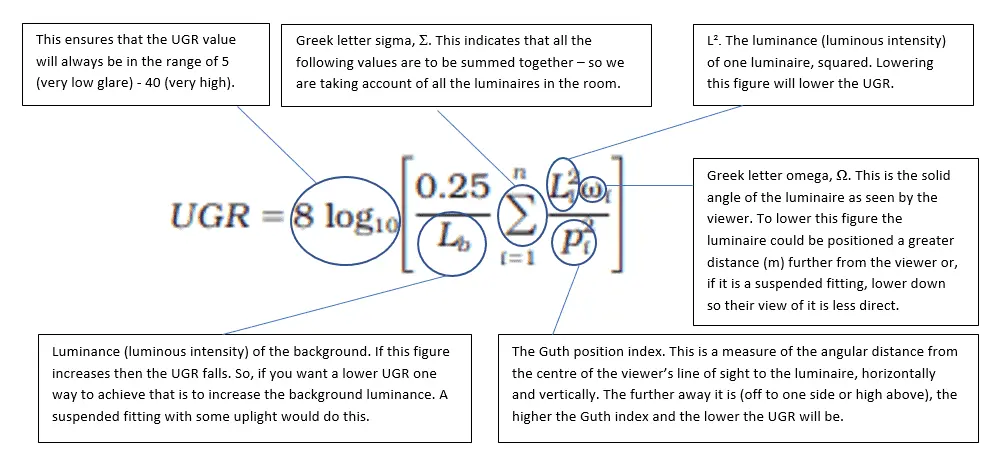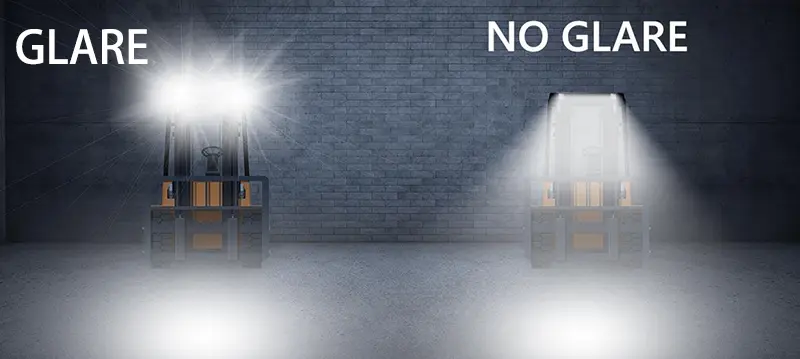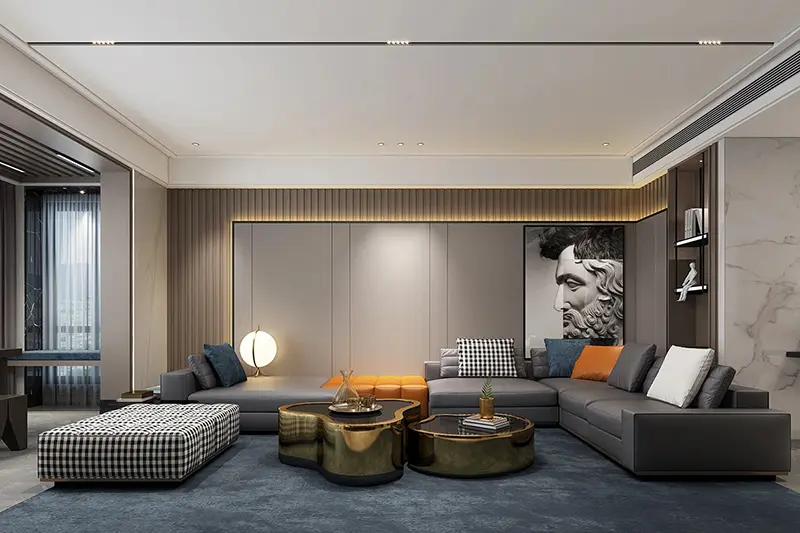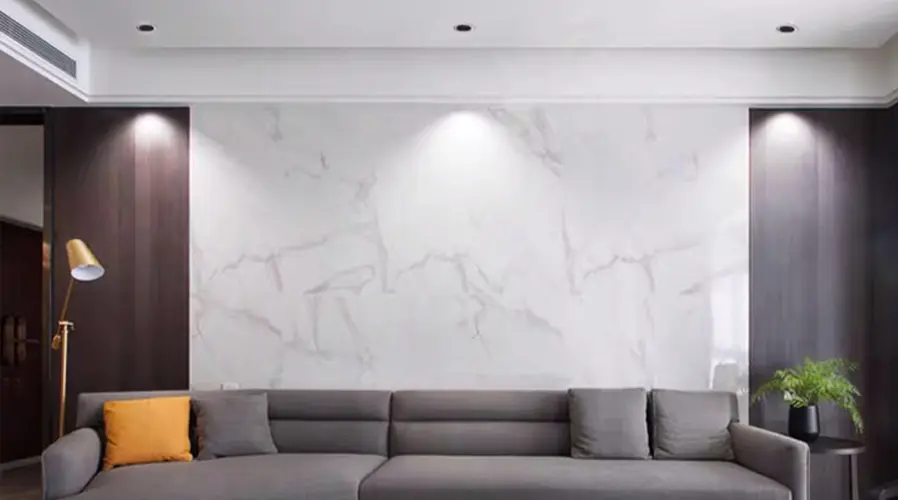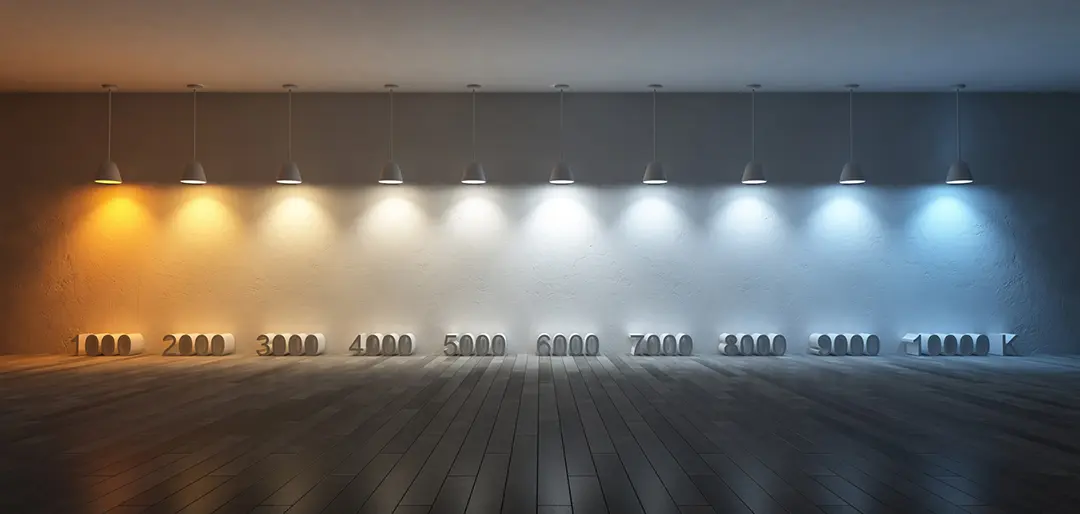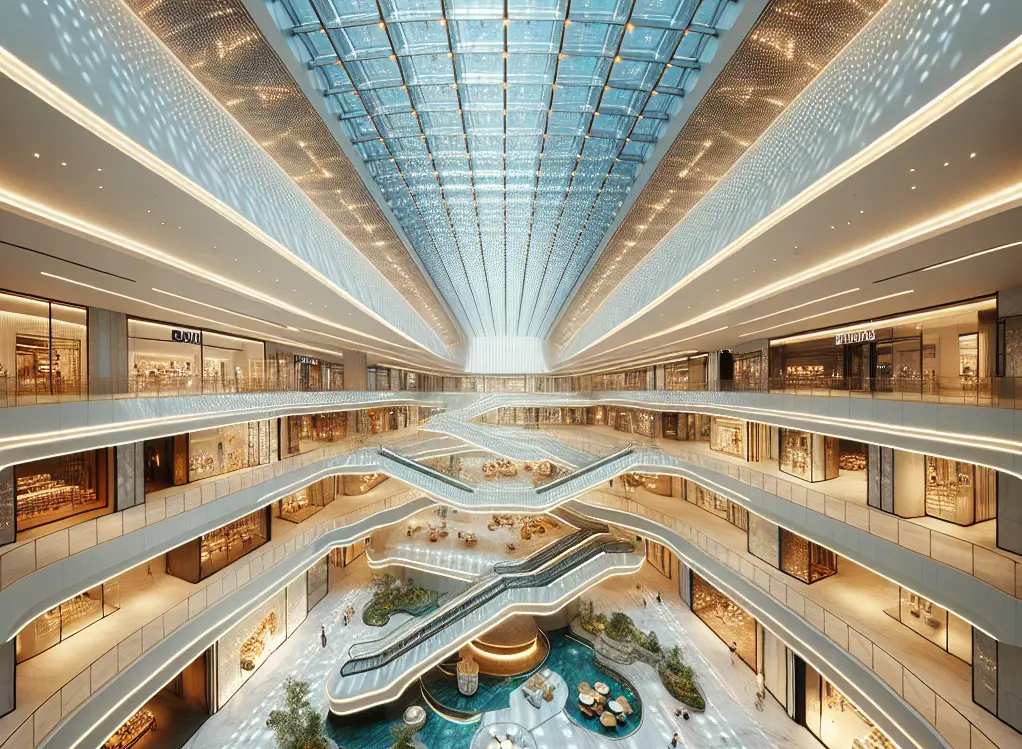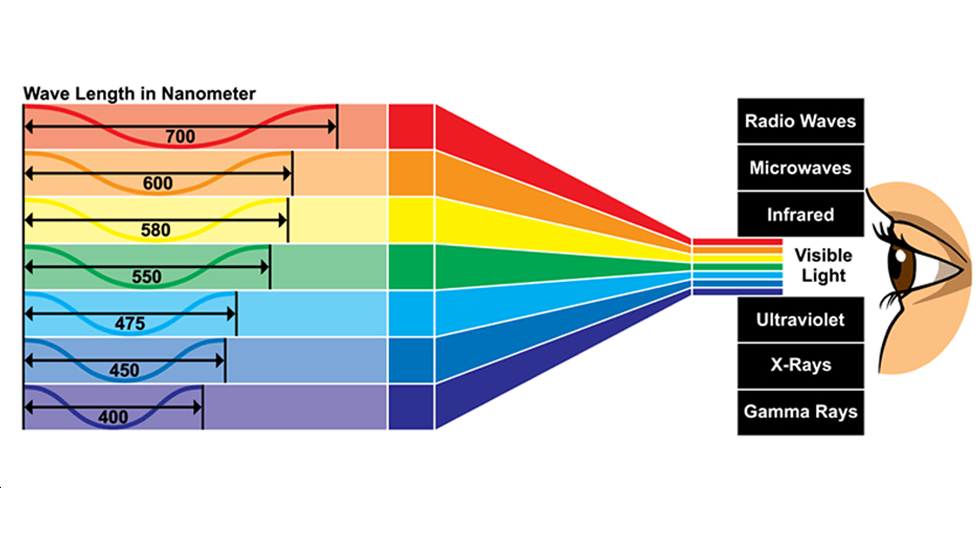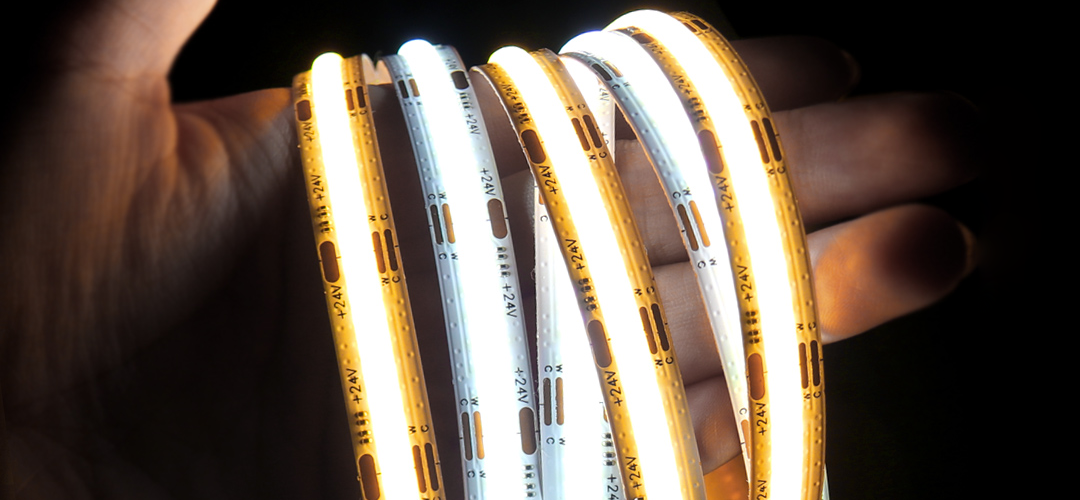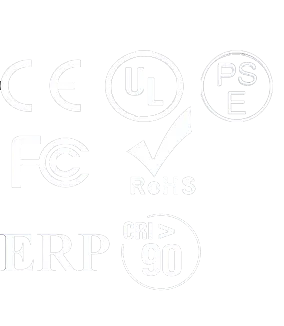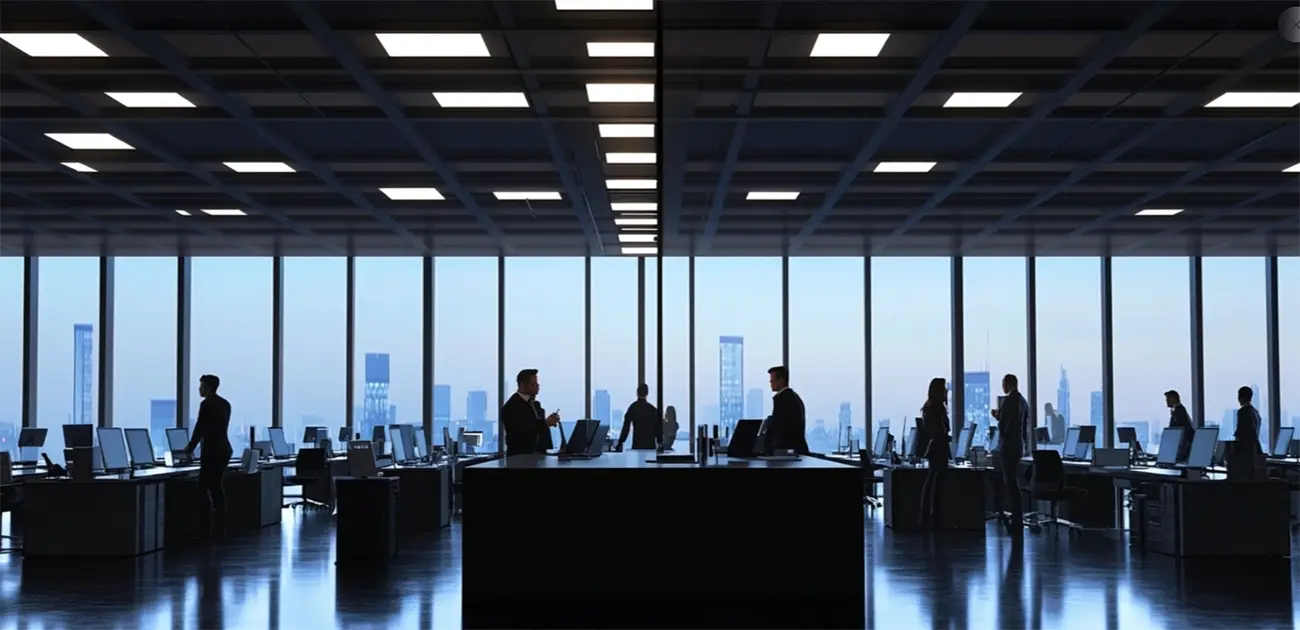
Everything you need to know about UGR: The key to improve light quality
In modern lighting design, the quality of LED lighting is not only reflected in brightness and color temperature but also in visual comfort. With the development of LED lighting technology, the brightness and efficiency of light sources have significantly improved. Enhancing visual comfort has become a crucial aspect of lighting design that cannot be overlooked. UGR (Unified Glare Rating) is a standard for measuring discomfort glare caused by light sources and is increasingly being applied in LED lighting design. This article will provide a detailed exploration of the definition of UGR, its importance in LED lighting, and how to optimize UGR values through design and technological methods to create a more comfortable lighting environment.
Table of Contents
What is UGR?
UGR stands for Unified Glare Rating, which is a method used to evaluate discomfort glare in lighting design. It is a standard developed by the International Commission on Illumination (CIE) to quantify the degree of visual discomfort experienced by people in indoor environments
UGR is primarily used to assess glare issues in artificial lighting design. It evaluates factors such as light source size and viewing position within a specific range, typically applied to conventional indoor environments. As an internationally standardized metric, it help designers reduce discomfort glare during the design process. The UGR value ranges from 10 to 30, with lower values indicating less glare and a more comfortable lighting environment. Common UGR value classifications are as follows:
| UGR<10: | Almost no glare; visual comfort is excellent |
|---|---|
| 10 ≤ UGR < 16: | Slight glare; most people will not experience discomfort |
| 16 ≤ UGR < 19: | Suitable for office environments; glare control is within an acceptable range |
| 19 ≤ UGR < 22: | Acceptable in specific situations, but prolonged exposure may cause discomfort |
| 22 ≤ UGR < 25: | Noticeable glare; generally unsuitable for most people |
| UGR > 25: | Severe glare; unsuitable for any long-term lighting environment |
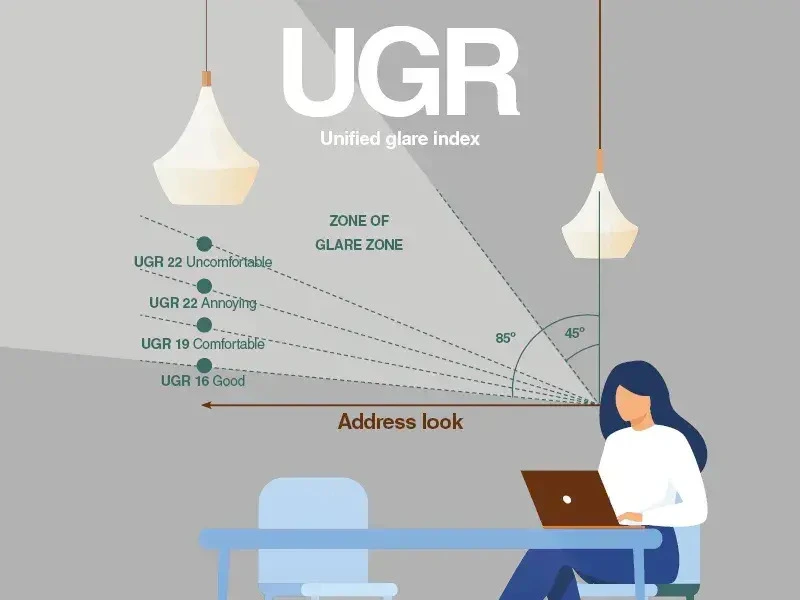
How to Caculate UGR?
The UGR calculation formula is relatively complex, involving multiple variables such as the luminance of the light source, the observer’s viewing angle, and the room’s reflectance. The basic form of the UGR formula is:
Using this formula, designers can control the UGR value during the lighting design phase by adjusting the luminance of light sources, selecting appropriate fixtures, and optimizing fixture placement to ensure that the final lighting environment achieves the desired level of visual comfort.
UGR and LED Lighting Relationship
LED Light Fixture are known for their high efficiency, long lifespan, and high brightness, making them widely used in various lighting designs. However, these advantages also pose challenges, particularly in glare management. LED fixtures typically have high brightness and strong directionality, which, if not properly designed, can result in high UGR values and cause discomfort glare.
-
LED Brightness and UGR
The brightness of LED light sources is a critical factor in determining UGR values. High-brightness LED fixtures, when not diffused, can produce concentrated beams that directly hit the observer’s eyes, leading to glare issues. To reduce glare, designers often incorporate diffusers or use optical lenses in fixtures to distribute light evenly, lower brightness contrast, and effectively control UGR values.
-
Optical Design of LED Fixtures
Modern LED fixtures feature advanced optical design technologies that enable early-stage glare control. By incorporating multi-layer reflectors, glare shields, and precision optical lenses, designers can control light distribution within the fixture, avoiding direct bright spots and reducing UGR values. For example, many high-end LED downlights and track lights use honeycomb glare shields, which not only reduce glare but also optimize light diffusion, making the entire space’s lighting more even and softer.
-
Fixture Layout and UGR Optimization
Light Fixture layout plays a crucial role in UGR control. By strategically placing and angling fixtures, designers can prevent direct light from reaching the observer’s eyes and use indirect lighting methods, such as reflecting light off walls or ceilings, to reduce glare. For instance, in office environments, fixtures can be installed out of the direct line of sight, using ceiling reflection to illuminate the space, thereby significantly lowering UGR values and enhancing visual comfort.
7 Big Factors to affect UGR
The main causes of glare in LED luminaires include the following aspects:
1. Excessive Brightness of the Light Source
The high brightness of LED light sources is one of the primary causes of glare. Compared to traditional light sources, LED luminaires can produce very high brightness within a small volume. If this high-brightness light source is directly exposed within the field of view, it can easily cause glare, leading to visual discomfort.
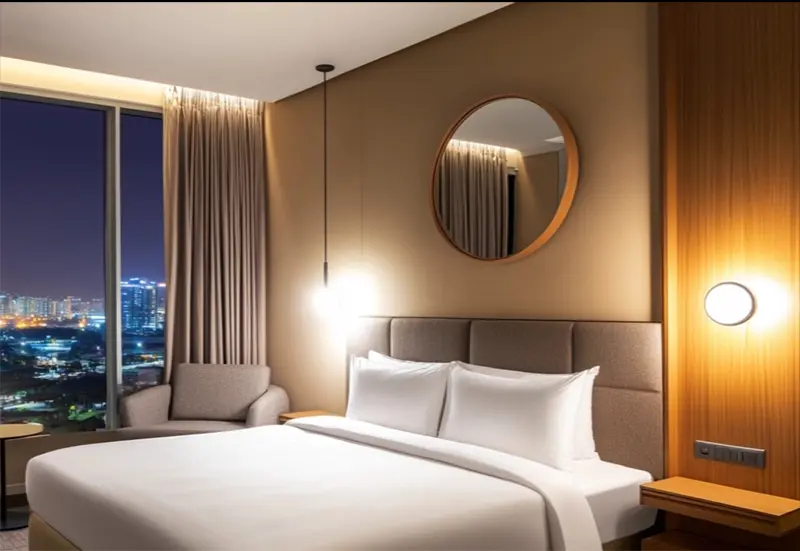
2. Improper Luminaire Design
The design of the luminaire plays a crucial role in glare. If the LED luminaire lacks effective anti-glare measures, such as not using light diffusion materials, shades, or anti-glare grilles, the light may directly enter the eyes, causing unnecessary glare.

3. Inappropriate Beam Angle
An improperly designed beam angle of LED luminaires can also lead to glare. If the beam is too narrow, the light will create a highly bright spot in a specific area, causing glare. On the other hand, a beam that is too wide may cause light to scatter into unwanted areas, and the reflected light entering the line of sight can also result in glare.
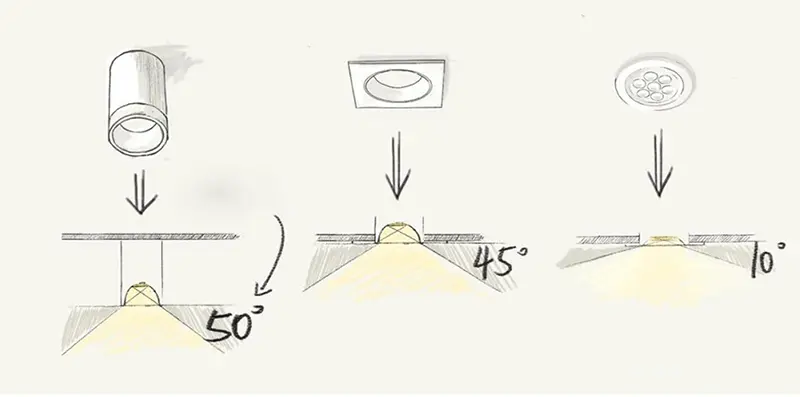
4. Incorrect Luminaire Position and Mounting Height
The position and mounting height of the luminaire directly affect the path of the light. If the LED luminaire is installed too low or directly within the line of sight, the light can easily enter the field of vision, causing glare. Additionally, if luminaires are placed too close together, it may result in excessively high brightness in localized areas, increasing the risk of glare.
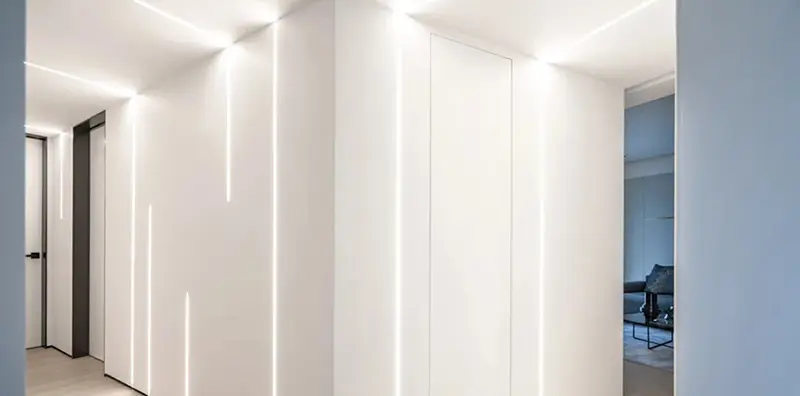
5. Reflected Light
Reflected light within the indoor environment is another significant cause of glare. Light emitted by LED luminaires can be reflected off smooth walls, floors, or furniture, and if it re-enters the eyes, it may increase the level of glare. This indirect glare is often overlooked in design but can also negatively impact visual comfort.
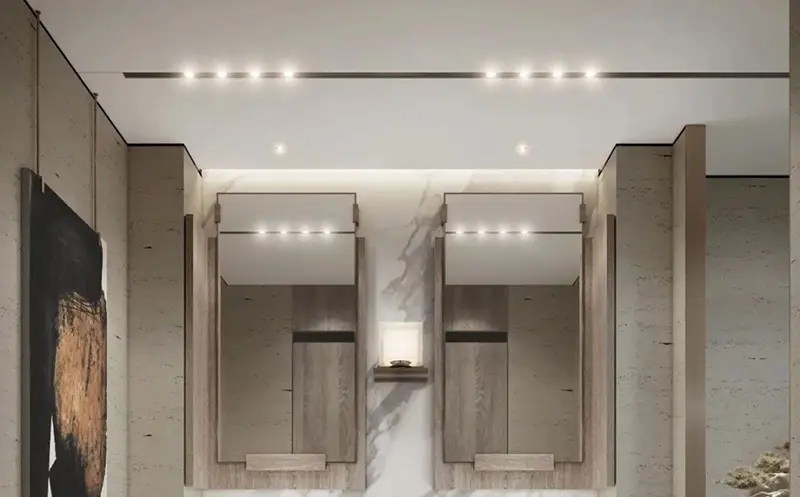
6. High Color Temperature
The color temperature of LED luminaires can also influence the occurrence of glare. Higher color temperatures (e.g., cool white light) generally give a brighter feel but are more likely to cause glare. In contrast, light sources with lower color temperatures (e.g., warm white light) provide softer light, reducing the risk of glare.
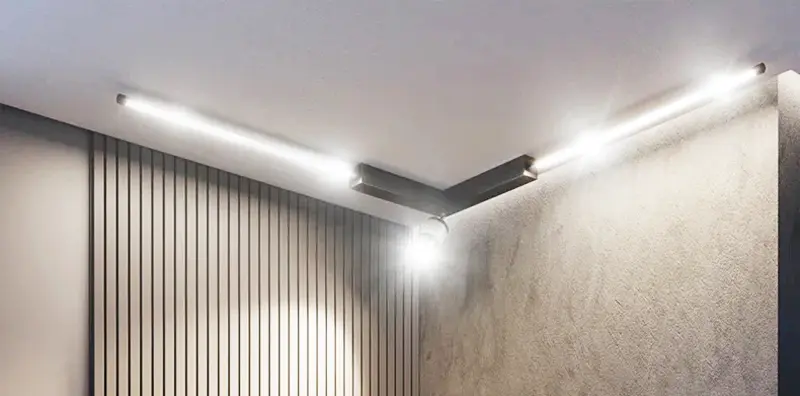
7. Strong Contrast in Ambient Light
High contrast in ambient light can also lead to glare. If one area of the room is excessively bright while surrounding areas are relatively dark, the eyes will experience discomfort when rapidly shifting between areas of different brightness, causing glare. Therefore, it is crucial to control the uniformity of light.
By understanding these causes of glare in LED luminaires, appropriate measures can be taken in design and usage, such as selecting proper luminaire designs, installation positions, beam angles, and choosing suitable light source brightness and color temperature. This will effectively reduce glare and improve the comfort of the indoor lighting environment.

What is good UGR in LED Lighting?
Different applications have varying requirements for UGR values. In practice, designers need to set appropriate UGR values based on the functional needs of specific scenarios to ensure a comfortable lighting environment.
-
Office Environments
In office environments, where prolonged lighting is required, visual comfort is paramount. High UGR values can lead to eye strain, lack of concentration, and reduced productivity. Typically, UGR values in office environments should be kept between 16 and 19 to ensure that most employees do not experience discomfort during working hours.
-
Educational Environments
Schools and educational institutions also have high standards for lighting, especially in classrooms, where lighting must provide sufficient brightness while strictly controlling glare to prevent students from experiencing visual fatigue during long study sessions. UGR values in educational environments are generally required to be below 19, with even lower values needed in special settings such as exam rooms or laboratories.
-
Commercial and Retail Environments
In commercial and retail environments, lighting design must not only showcase products but also create an inviting shopping atmosphere. High UGR values can negatively impact the shopping experience and even diminish the appeal of products. Therefore, retail lighting often employs low UGR<19 designs to ensure that customers do not feel uncomfortable due to glare while browsing. By using indirect lighting and carefully designed LED fixtures, the balance between illumination and glare control can be achieved, enhancing customer satisfaction.
-
Healthcare and Medical Environments
Lighting design in healthcare facilities is even more stringent because patients’ visual comfort directly impacts their recovery process. Lighting in hospitals, clinics, and other medical environments must provide sufficient brightness to support medical work while ensuring low UGR values to avoid discomfort for patients. These environments typically require UGR values below 16, with specialized anti-glare fixtures used in areas such as operating rooms and recovery rooms to ensure the highest lighting quality.
5. Residential Enviroments
In addition to commercial and institutional settings, UGR plays a significant role in residential lighting design. the recommended UGR (Unified Glare Rating) value is typically between 16 and 19 to ensure visual comfort. For spaces where people spend extended periods, such as living rooms and bedrooms, a lower UGR value, ideally below 16, is preferred to minimize glare and create a comfortable atmosphere. Maintaining these values helps prevent eye strain and discomfort, contributing to a relaxing and visually pleasing home environment.
6. Factory Environment
In factory environments, the recommended UGR value is typically below 22. This value helps ensure that glare is minimized, maintaining a safe and comfortable working environment. UGR values between 16 and 19 are considered optimal for areas requiring precise visual tasks, while values above 22 may cause discomfort and reduce productivity. Proper lighting design, including the use of anti-glare fixtures and appropriate fixture placement, is essential to achieve these UGR levels in industrial settings.
The BS EN 12464 standard offers recommended maximum UGR (Unified Glare Rating) levels for various working environments to ensure visual comfort. While these recommendations are widely accepted as best practices, they are not legally binding requirements. The UGR levels suggested by the standard vary depending on the specific tasks and settings, with lower values recommended for areas requiring high visual accuracy and comfort. Implementing these guidelines can help optimize lighting conditions and improve the overall work environment.
|
UGR limits for interior areas, tasks and activities |
||
| BSEN12464 table | Type of area, task or activity (no. of sub-divisions) | Maximum UGR |
| 5.1 | Traffic zones inside buildings (4) | 25-28 |
| 5.2 | Rest, sanitation & first aid rooms (6) | 16-25 |
| 5.3 | Control rooms (2) | 19-25 |
| 5.4 | Store rooms & cold stores (2) | 25 |
| 5.5 | Storage rack areas (4) | 22 |
| 5.6 | Industrial activities & crafts – Agriculture (4) | 25 |
| 5.7 | Industrial activities & crafts – bakeries (2) | 22 |
| 5.8 | Industrial activities & crafts – Cement, cement goods (4) | 25-28 |
| 5.9 | Industrial activities & crafts – Ceramics, tiles etc (7) | 16-28 |
| 5.10 | Industrial activities & crafts – Chemical, plastic etc (8) | 16-28 |
| 5.11 | Industrial activities & crafts – Electrical & electronics (6) | 16-25 |
| 5.12 | Industrial activities & crafts – Foodstuffs, luxury food (8) | 16-25 |
| 5.13 | Industrial activities & crafts – Foundries & casting (11) | 22-25 |
| 5.14 | Industrial activities & crafts – Hairdressers (1) | 19 |
| 5.15 | Industrial activities & crafts – Jewellery mfg. (4) | 16-19 |
| 5.16 | Industrial activities & crafts – Laundries, dry cleaning (4) | 19-25 |
| 5.17 | Industrial activities & crafts – Leather, leather goods (9) | 16-25 |
| 5.18 | Industrial activities & crafts – Metal working (14) | 19-25 |
| 5.19 | Industrial activities & crafts – Paper (3) | 22-25 |
| 5.20 | Industrial activities & crafts – Power stations (5) | 16-28 |
| 5.21 | Printers (5) | 16-19 |
| 5.22 | Industrial activities & crafts – Rolling mills, iron, steel (9) | 22-28 |
| 5.23 | Industrial activities & crafts – Textiles (13) | 19-28 |
| 5.24 | Industrial activities & crafts – Vehicles (6) | 19-22 |
| 5.25 | Industrial activities & crafts – Wood (9) | 19-28 |
| 5.26 | Offices (7) | 16-25 |
| 5.27 | Retail premises (3) | 19-22 |
| 5.28 | Places of public assembly, general areas (4) | 22-15 |
| 5.29 | Places of public assembly – Restaurants & hotels (7) | 19-25 |
| 5.30 | Places of public assembly – Theatres, cinemas etc (4) | 22 |
| 5.31 | Places of public assembly – Trade fairs & exhibitions (1) | 22 |
| 5.32 | Places of public assembly – Museums (2) | n/a |
| 5.33 | Places of public assembly – Libraries (3) | 19 |
| 5.34 | Places of public assembly – Public car parks indoor (5) | 19-25 |
| 5.35 | Educational premises – Nursery school, play school (3) | 19-22 |
| 5.36 | Educational premises – Educational buildings (26) | 16-25 |
| 5.37 | Health care premises – Rooms for general use (8) | 22 |
| 5.38 | Health care premises – Staff rooms (2) | 19 |
| 5.39 | Health care premises – Wards, maternity wards (6) | 19-22 |
| 5.40 | Health care premises – Examination rooms (general) (2) | 19 |
| 5.41 | Health care premises – Eye examination rooms (2) | 19 |
| 5.42 | Health care premises – Ear examination rooms (2) | 19 |
| 5.43 | Health care premises – Scanner rooms (2) | 19 |
| 5.44 | Health care premises – Delivery rooms (2) | 19 |
| 5.45 | Health care premises – Treatment rooms (general) (6) | 19 |
| 5.46 | Health care premises – Operating areas (3) | 19 |
| 5.47 | Health care premises – Intensive care unit (4) | 19 |
| 5.48 | Health care premises – Dentists (4) | 19 |
| 5.49 | Health care premises – Laboratories & pharmacies (2) | 19 |
| 5.50 | Health care premises – Decontamination rooms (2) | 22 |
| 5.51 | Health care premises – Autopsy rooms & mortuaries (2) | 19 |
| 5.52 | Transportation areas – Airports (11) | 16-25 |
| 5.53 | Transportation areas – Railway installations (11) | 19-28 |
How to reduce and Optimized UGR in LED Lighting?
To optimize UGR values in LED lighting, users /designers can employ various strategies, including selecting the right fixtures, optimizing layout, refining optical design, and leveraging advanced technologies. Additionally, advanced technological solutions can play a significant role in real-time UGR adjustment.
- Choosing Anti-Glare LED Lighting Fixtures
Choosing Anti-Glare LED fixtures is a direct way to reduce glare. These fixtures are usually specially designed to effectively diffuse light, lower brightness contrast, and reduce glare. Examples of Anti-Glare fixtures include LED track lights, LED downlights with diffusers, and more.
-
Strategic Fixture Layout
Strategic Fixture Layout
Strategic fixture layout is crucial for controlling UGR. Designers should avoid placing fixtures at eye level or directly in front of the observer and instead use indirect or reflected lighting to minimize direct light. By adjusting the height and angle of fixtures, light direction and distribution can be effectively controlled, optimizing UGR values.
- Advanced Optical Design
Advanced optical design technologies, such as honeycomb glare shields, multi-layer reflectors, and precision optical lenses, can achieve effective light control within the fixture. These technologies not only reduce glare but also improve light uniformity and diffusion, making the overall lighting environment more comfortable.
-
Smart Control Systems
Smart Control Systems
With the development of IT technology, smart lighting control systems are becoming more common. These systems can automatically adjust the brightness and color temperature of fixtures based on changes in ambient light, dynamically controlling UGR values. For example, on a sunny day, the system can automatically lower the brightness of indoor fixtures, reducing glare while saving energy. At night or in low-light conditions, the system can increase the brightness as needed, ensuring the desired lighting effect while controlling UGR values.
- Incorporating Ergonomic Design
Ergonomics in lighting design can significantly enhance UGR optimization. Users need to consider the specific needs of the space and apply ergonomic principles to fixture placement and light design, ensuring that the lighting meets functional requirements without causing discomfort glare. Proper fixture height, installation angles, and light source direction should all be carefully calculated to reduce direct glare.
-
Using Multi-Layer Reflection Technology
Using Multi-Layer Reflection Technology
Multi-layer reflection technology can further optimize UGR values. By adopting multi-layer reflectors within fixtures, light can be evenly scattered throughout the space, reducing the occurrence of direct glare. This technology is commonly used in large spaces with high ceilings, such as conference rooms, exhibition halls, and shopping centers, ensuring a more uniform and softer lighting effect.
- Combining Indirect and Direct Lighting
Combining indirect and direct lighting in design can effectively lower UGR values. Indirect lighting illuminates the space by reflecting light, reducing the possibility of direct glare. Direct lighting, on the other hand, ensures that light is directed only to the necessary areas through precise fixture control. This combination enhances overall lighting effects while improving visual comfort, making it particularly suitable for long-term use spaces like offices, educational institutions, and healthcare facilities.
Best solution – Anti-Glare LED Lighting for projects
Anti-glare LED lighting offers numerous advantages to reduce glare affection, including enhanced visibility, reduced eye strain, improved energy efficiency, and better color rendition. These benefits make it an appealing choice for both residential and commercial lighting applications.
-
Improved Visual Comfort
One of the key advantages of anti-glare LED lighting is its ability to reduce eye strain and discomfort by minimizing harsh reflections and brightness contrasts, creating a more pleasant environment for work or relaxation. Traditional lighting can cause discomfort and fatigue due to intense brightness and glare, whereas anti-glare technology diffuses light more evenly. This leads to a more comfortable viewing experience over extended periods, which is essential in modern workspaces and educational environments.
2. Enhanced Safety
In industrial and commercial settings, controlling glare helps prevent accidents by ensuring clear visibility and reducing distractions caused by bright lights.
3. Better Productivity
Anti-glare LED lighting significantly improves visibility by minimizing distracting reflections and harsh brightness levels. This feature can be particularly beneficial in environments such as offices, hospitals, and schools, where clear sightlines are crucial for both safety and productivity.
4. Saving more energy
Anti-glare LED light systems are generally more energy-efficient compared to conventional lighting alternatives. As LEDs consume less power while providing the same or superior illumination quality, they contribute to lower energy bills and reduced carbon footprints. This aspect is crucial for both environmental sustainability and cost management.
5.Aesthetic Appeal
Another significant benefit of anti-glare LED lighting is its ability to enhance the overall look of a space by providing soft and better color rendition, evenly distributed light without unsightly glare spots.It allows colors to appear more vibrant and true to life, which can be particularly important in applications such as art galleries, retail spaces, and design studios. Proper color representation enhances the overall aesthetic quality and supports the tasks performed in these environments
Sunroleds- Customized your Anti-Glare LED Downlights, Track Lights UGR<15
- Tailored Lighting Precision
Customizable various beam angles allow for targeted illumination, enhancing lighting effectiveness in various settings.
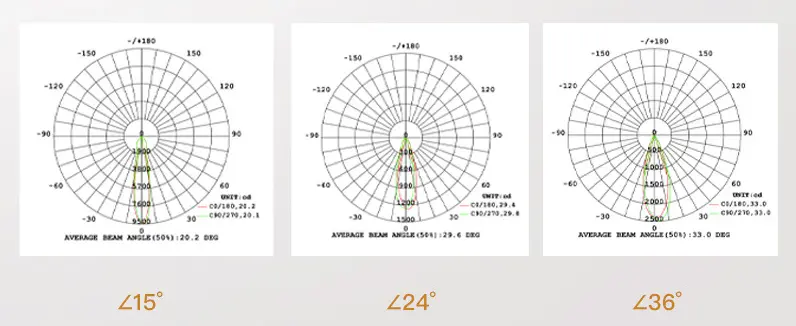
- Visual Comfort:
Customized Different types of Anti-glare optical covers reduce glare, improving visual comfort and reducing eye strain.
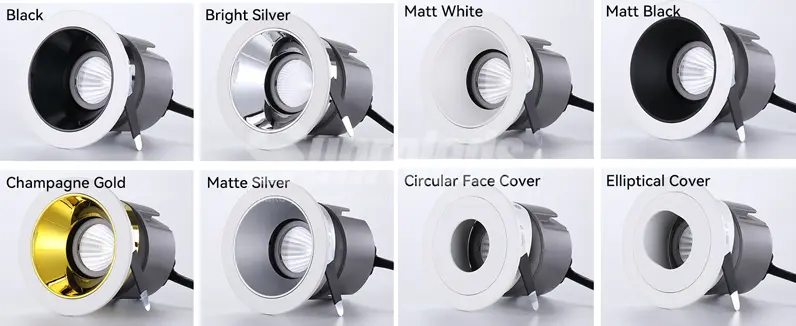
- Glare Control
Honeycomb structures and UGR <15 ensure minimal glare for a comfortable visual environment.
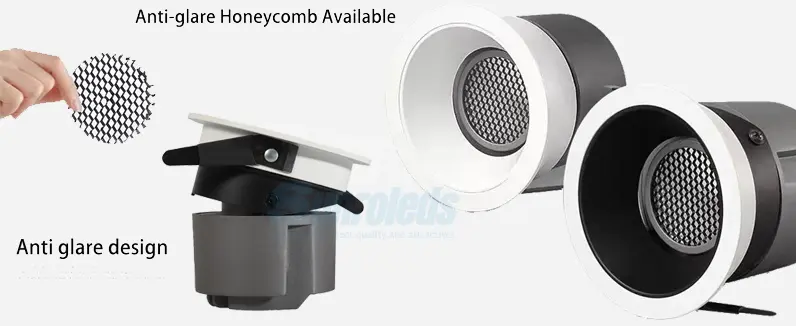
- Custom Color Temperature
Custom optical cover colors and adjustable color temperatures create the perfect ambiance for any space.
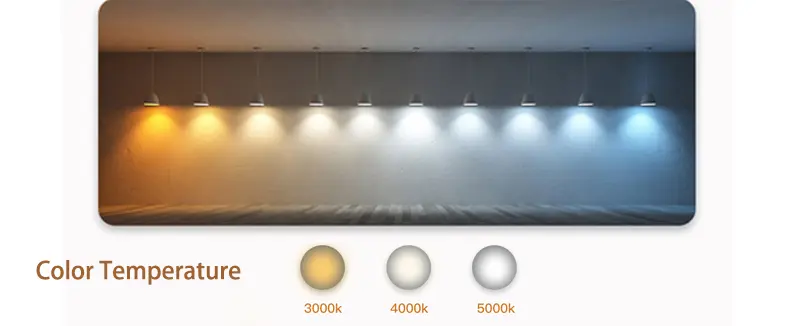
- Dimming Flexibility
Options like 0-10V, DALI, or TRIAC dimming provide control over lighting levels, adapting to different needs.
- Custom Accurate Color Rendering:
Custom CRI >80 or CRI> 90 for vibrant, true-to-life colors.

- Custom with LED Brand, Consistent Light Quality
SDCM <2 guarantees uniform color consistency, Cree ,Epsitar , Osram LED Brand optional, 3-5 years warranty, ideal for professional applications.
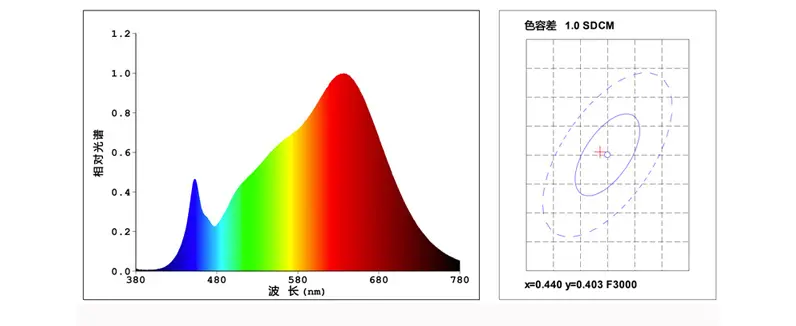
Conclusion
UGR is a critical factor in achieving comfortable and effective lighting in residential environments. By carefully selecting fixtures, planning thoughtful layouts, and utilizing advanced control systems, homeowners and designers can create spaces that cater to both functional needs and aesthetic desires while minimizing discomfort caused by glare. Attention to UGR in residential lighting not only enhances daily living experiences but also contributes to health, well-being, and overall quality of life.
As technology advances and awareness of lighting’s impact on human health grows, the Anti-glare LED Light fixtures demand will continue to increase. Future developments may include more sophisticated smart lighting solutions that automatically adjust to optimize UGR based on real-time conditions and user behavior, further enhancing the comfort and adaptability of residential spaces. Through mindful design and innovative technology, achieving optimal lighting that harmoniously blends functionality and comfort is well within reach for modern homes.
Share this article
Written by : Sophia Ng
Hey there! This is Sophia Ng, Worked for Sunroleds with 15 years in the industry, specializing in sales and marketing.
I'm committed to excellence and always aim to exceed expectations. Outside of work, I enjoy traveling and exploring traditional Chinese culture.
Let's connect and make some magic happen!
Follow us
Latest articles
September 16, 2024
September 16, 2024
September 16, 2024
September 16, 2024

